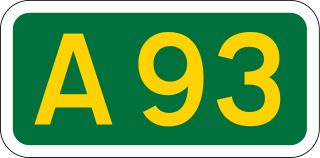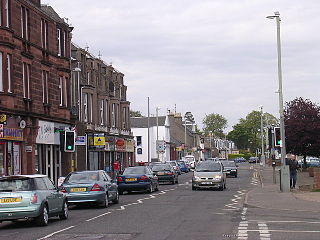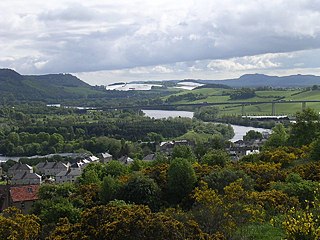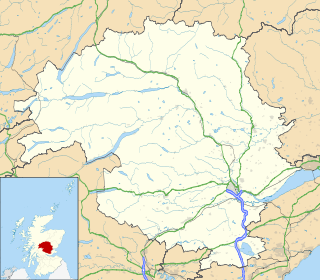| Wolfhill | |
|---|---|
 | |
Location within Perth and Kinross | |
| Population | 316 |
| OS grid reference | NO155334 |
| Council area | |
| Country | Scotland |
| Sovereign state | United Kingdom |
| Post town | Perth |
| Postcode district | PH2 |
| Police | Scotland |
| Fire | Scottish |
| Ambulance | Scottish |
| EU Parliament | Scotland |
Wolfhill is a village in Perthshire, Scotland, with a population of 316 (2001 census). Formerly known as Carolina, it was given the nickname of "Snipetown" many years ago by locals, owing to the high numbers of snipes that used to inhabit the area.
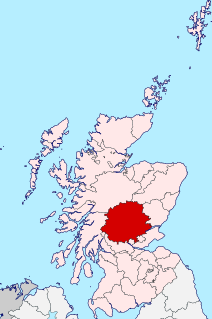
Perthshire, officially the County of Perth, is a historic county and registration county in central Scotland. Geographically it extends from Strathmore in the east, to the Pass of Drumochter in the north, Rannoch Moor and Ben Lui in the west, and Aberfoyle in the south; its borders the counties of Inverness-shire and Aberdeenshire to the north, Angus to the east, Fife, Kinross-shire, Clackmannanshire, Stirlingshire and Dunbartonshire to the south and Argyllshire to the west. It was a local government county from 1890 to 1930.

Scotland is a country that is part of the United Kingdom. It covers the northern third of the island of Great Britain, with a border with England to the southeast, and is surrounded by the Atlantic Ocean to the north and west, the North Sea to the northeast, the Irish Sea to the south, and more than 790 islands, including the Northern Isles and the Hebrides.

A snipe is any of about 26 wading bird species in three genera in the family Scolopacidae. They are characterized by a very long, slender bill and crypsis, or camouflage, plumage. The Gallinago snipes have a nearly worldwide distribution, the Lymnocryptes snipe is restricted to Asia and Europe and the Coenocorypha snipes are found only in the outlying islands of New Zealand. The four species of painted snipe are not closely related to the typical snipes, and are placed in their own family, the Rostratulidae.
The hamlet is near the source of the Burrelton Burn and lies between the Sidlaw Hills and the River Tay, 2 miles (3 km) north east of Guildtown and 7 miles (11 km) north-east of Perth.

The River Tay is the longest river in Scotland and the seventh-longest in the United Kingdom. The Tay originates in western Scotland on the slopes of Ben Lui, then flows easterly across the Highlands, through Loch Dochart, Loch Iubhair and Loch Tay, then continues east through Strathtay, in the centre of Scotland, then southeasterly through Perth, where it becomes tidal, to its mouth at the Firth of Tay, south of Dundee. It is the largest river in the UK by measured discharge. Its catchment is approximately 2,000 square miles (5,200 km2), the Tweed's is 1,500 square miles (3,900 km2) and the Spey's is 1,097 square miles (2,840 km2).

Perth is a city in central Scotland, on the banks of the River Tay. It is the administrative centre of Perth and Kinross council area and the historic county town of Perthshire. It has a population of about 47,180. Perth has been known as The Fair City since the publication of the story Fair Maid of Perth by Scottish writer Sir Walter Scott in 1828. During the later medieval period the city was also called St John's Toun or Saint Johnstoun by its inhabitants in reference to the main church dedicated to St John the Baptist. This name is preserved by the city's football teams, St Johnstone F.C.
Close to Wolfhill are examples of pre-historic standing stones. One of the best-known sites in folklore is "The Witches' Stane" located between Wolfhill and St Martins. According to local legend, this was the stone to which Macbeth's witches were chained, and it does indeed bear chain marks. "MacBeth's Castle" (a hill fort) can be found at the nearby village of Collace, near the Council Quarry on the Sidlaws.
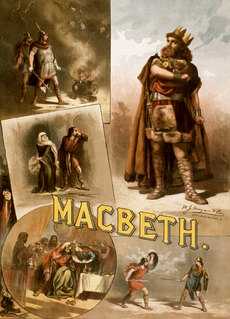
Macbeth is a tragedy by William Shakespeare; it is thought to have been first performed in 1606. It dramatises the damaging physical and psychological effects of political ambition on those who seek power for its own sake. Of all the plays that Shakespeare wrote during the reign of James I, who was patron of Shakespeare's acting company, Macbeth most clearly reflects the playwright's relationship with his sovereign. It was first published in the Folio of 1623, possibly from a prompt book, and is Shakespeare's shortest tragedy.

Collace is a parish in Perthshire, Scotland, lying 8 miles north-east of Perth, in the Carse of Gowrie district. The parish boundary includes the neighbouring villages of Kinrossie and Saucher.
There are varying stories on how the village got its name, one being that the "Wolf of Badenoch" (Alexander Stewart, Earl of Buchan) camped there before going to Perth in the 14th century to be officially forgiven by the church for his evil ways. He is buried at Dunkeld Cathedral in a cask.

Alexander Stewart, Earl of Buchan, Alasdair Mór mac an Rígh, and called the Wolf of Badenoch, was the third surviving son of King Robert II of Scotland and youngest by his first wife, Elizabeth Mure of Rowallan. He was the first Earl of Buchan since John Comyn, from 1382 until his death. Alexander married the widowed Euphemia I, Countess of Ross, but they had no children. He did have a large family by his longtime mistress, Mairead inghean Eachainn. Alexander was Justiciar of Scotia for a time, but not an effective one. He held large territories in the north of Scotland before eventually losing a large part of them. Alexander is remembered for his destruction of the royal burgh of Elgin and its cathedral. His nickname was earned due to his notorious cruelty and rapacity, but there is no proof that it was used during his lifetime.

Dunkeld Cathedral is a Church of Scotland place of worship which stands on the north bank of the River Tay in Dunkeld, Perth and Kinross, Scotland. Built in square-stone style of predominantly grey sandstone, the cathedral proper was begun in 1260 and completed in 1501. It stands on the site of the former Culdee Monastery of Dunkeld, stones from which can be seen as an irregular reddish streak in the eastern gable.
It is also said that the last wolf in Scotland was killed in Wolfhill but many other villages across the country lay claim to the same story. There is no doubt that wolves inhabited the area at one time. The monks of nearby Coupar Angus Abbey, who formerly owned the land, stipulated in certain mid-16th-century lease agreements recorded in the document known today as the Rent Book of Coupar-Angus Abbey (Rogers 1880; pages 251, 262) that tenants were required to "... sustene and nwrice ane leche of hundis for tod and wolf.."– that is to say, "...sustain and nourish a leash of hounds for (hunting) fox and wolf..".

The wolf, also known as the gray/grey wolf, is a canine native to the wilderness and remote areas of Eurasia and North America. It is the largest extant member of its family, with males averaging 43–45 kg (95–99 lb) and females 36–38.5 kg (79–85 lb). It is distinguished from other Canis species by its larger size and less pointed features, particularly on the ears and muzzle. Its winter fur is long and bushy and predominantly a mottled gray in colour, although nearly pure white, red and brown to black also occur. Mammal Species of the World, a standard reference work in zoology, recognizes 38 subspecies of C. lupus.

Coupar Angus Abbey was a Cistercian monastery near Coupar Angus, in central Scotland, on the boundary between Angus and Gowrie.

A lease is a contractual arrangement calling for the lessee (user) to pay the lessor (owner) for use of an asset. Property, buildings and vehicles are common assets that are leased. Industrial or business equipment is also leased.
Birthplace of James Croll, FRS, joiner, janitor, librarian and arguably first world climatologist.

James Croll, FRS, was a 19th-century Scottish scientist who developed a theory of climate change based on changes in the Earth's orbit.
| Wikimedia Commons has media related to Wolfhill . |



